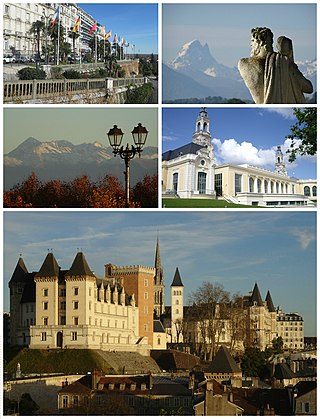Opening
On 16 October 1910, the Stade de la Croix du Prince was inaugurated during a match against Bergerac, with over 3,000 spectators attending. [3] Section won 13-0. By 1913, the stadium had to undergo renovations to increase its capacity and comfort. [4]
The construction of the stands began in 1913 when Section Paloise decided to enhance its infrastructure in response to increasing attendance. To finance these improvements, the general assembly approved a loan, and within a week, 20,000 francs were secured. The work, overseen by the Lalaserre company and architect Jules-Antoine Noutary, started in the summer and was completed before 10 September 1910. The stadium was inaugurated on 5 October 1913, during a match against CA Périgueux, which ended in a decisive victory for Section Paloise, 35-6.
On 23 November 1913, Section Paloise achieved a memorable feat by defeating the reigning French champion, Aviron Bayonnais, 10-0 in front of a crowd of 8,000 spectators. [5] This match was seen as a pivotal moment in the history of rugby in Pau, highlighting the club's potential just a few years after it had decided to fully commit to Rugby Union, leaving behind its previous focus on barrette.
Following this, the stadium became the venue for several important rugby encounters. On 7 December 1913, it hosted a selection from the French national rugby team, drawing 10,000 spectators. The press praised the quality of the facilities and the stadium's accessibility thanks to the tram service. [6]
Another historic moment occurred on 4 May 1919, when the stadium was chosen to host a match against the All Blacks, a New Zealand military team touring Europe. [7] This match pitted a regional selection from Béarn & Gascony against the All Blacks, who emerged victorious with a score of 16-6. [8] This event drew media attention and marked a significant moment in the history of rugby in Pau.
In 1923, the stadium was the site of a major national selection match that determined the final composition of the French team. [9] Despite inclement weather, the match attracted over 10,000 spectators. [10] In 1925, Section Paloise faced off against the players from the University of Oxford, further solidifying its reputation on the international stage. In 1926, the stadium welcomed the Māori All Blacks, who played against a selection from Gascony, winning the match 11-6 during a highly anticipated European tour. [11] In 1928, Section Paloise claimed its first title of French champion, cementing its place in French rugby history. [12]
On 20 December 1932, the stadium hosted a friendly match between Section Paloise and FC Barcelona, the champions of Spain, which the sectionnistes won with a score of 36-27. [13]
In the 1950s, the stadium experienced record attendance, with over 14,000 spectators during derbies against FC Lourdes. [14] In 1960, a preparatory match between France A and France B drew over 16,000 people. [14] The Australian Wallabies also faced a regional selection at the stadium in 1958, winning the match 17-14. [15] In 1964, to celebrate the French championship title, 30,000 people gathered there to welcome the players.
In 1965, the France national rugby union team hosted Italy at La Croix du Prince . The French team won 21 to 0. [16]











